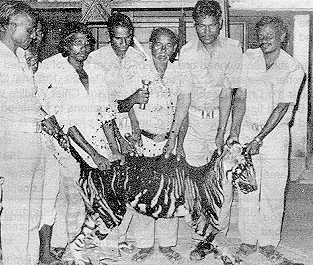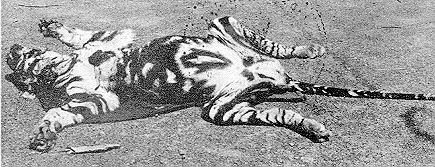New Reports of the Black Tigers of India
Posted by: Loren Coleman on October 29th, 2008
One of the most disputed felid cryptids is the “Black Tiger” of the Similipal Tiger Reserve.
The State Forest Department and Dehra Dun-based Wildlife Institute of India (WII) may have a huge difference of opinion over exact number of tigers in Bhubaneswar State, but the agencies are unanimous over presence of melanistic tigers in Similipal.
Even as the State and WII continue to be at loggerheads not only over number of big cats but enumeration methodology too, there is no such difference as far as melanistic (some call it black) tigers are concerned.
‘Wildlife Census in Orissa,’ a latest publication by the Forest and Environment Department, has confirmed the fact that tigers with colour aberration, mostly towards black, are found in Similipal Tiger Reserve (STR).
It comes to light through WII’s camera trap technology, a methodology which left the State Government ruffled when the National Tiger Conservation Authority (NTCA) and Dehra Dun-based institute released results of tiger census earlier this year. Interestingly, the publication puts the number of tigers at 132 in habitats across the State. The figure for Similipal is 69 (excluding cubs) as per the pugmark tracking method.
This almost is a climb-down from the higher figure of 94 that the Department had been dishing out for past several years, after it met with serious posers from camera trap technique used by WII-NTCA which led to a drop in the number. The controversial WII census had put tiger number at 45 in the entire State, and 20 in Similipal.
However, there is no such controversy over presence of the melanistic tigers though. The Forest Department publication, while terming the analysis of the camera trap as unclear, says that the method needs to be tested in different habitats.
But it presents pictures of the census showing the ‘black’ coloured tigers in STR. ‘‘It substantiates the postulation made on the basis of research carried out in STR on colour aberration in tiger in the research work Born Black: The Melanistic Tiger in India,’’ the report says.
The Similipal Tiger Reserve is situated in the district of Mayurbhanj, Orissa, India. It lies between 86°5′ and 86°37′ east longitude and between 21°30′ and 22°8′ north latitude. Beginning in 1975–1976 a number of sightings of black tigers have occurred in Similipal Tiger Reserve.
Observation 1993: On 21 July 1993, around 10 a.m., a boy, in self-defense, killed a young melanistic tigress with a bow and arrows. The incident occurred in the village of Podagad in the Bhandan river valley west of Similipal Tiger Reserve. The main peculiarity in body colouration was that the dorsal stripes were tawny and the ventral stripes white on a black background [or the black stripes were wider than the orange dorsal and white ventral backgrounds, ed.]. The animal was photographed (see photos) and videotaped.
Sources: Express Buzz, B. C. Prusty’s research.
About Loren Coleman
Loren Coleman is one of the world’s leading cryptozoologists, some say “the” leading living cryptozoologist. Certainly, he is acknowledged as the current living American researcher and writer who has most popularized cryptozoology in the late 20th and early 21st centuries.
Starting his fieldwork and investigations in 1960, after traveling and trekking extensively in pursuit of cryptozoological mysteries, Coleman began writing to share his experiences in 1969. An honorary member of Ivan T. Sanderson’s Society for the Investigation of the Unexplained in the 1970s, Coleman has been bestowed with similar honorary memberships of the North Idaho College Cryptozoology Club in 1983, and in subsequent years, that of the British Columbia Scientific Cryptozoology Club, CryptoSafari International, and other international organizations. He was also a Life Member and Benefactor of the International Society of Cryptozoology (now-defunct).
Loren Coleman’s daily blog, as a member of the Cryptomundo Team, served as an ongoing avenue of communication for the ever-growing body of cryptozoo news from 2005 through 2013. He returned as an infrequent contributor beginning Halloween week of 2015.
Coleman is the founder in 2003, and current director of the International Cryptozoology Museum in Portland, Maine.












It’s interesting that the “black” tigers tend to be smaller than average – possibly their smaller size and the hyperabundant pigmentation are both results of their restricted gene pool. These tigers’ coloration appears to be the result of abundism rather than true melanism. Abundism is an increase in the amount of pigmentation that causes patterns such as spots or stripes to be bigger or more numerous than is usual. It’s also called pseudomelanism. True melanism causes the entire coat to be black or nearly black, with the pattern of spots or stripes discernible under the overall black. Abundism can be so extreme as to make the entire animal appear to be black or black “cobwebbed” with a lighter color, but it is different from true melanism. To the best of my knowledge, no truly melanistic tigers have ever been documented.
Shuker records numerous reports in Mystery Cats of the World, some of them impressive but none later than the 1950s. He thought it likely that true melanistic tigers did occur in India.
Nice added info, Kittenz, thanks!
I think that truly melanistic tigers probably occur from time to time. In fact since melanism seems to have a decided evolutionary benefit in many cat species, it probably occurs (or has occurred) in every cat species at some point.
What we are really seeing in smaller, more isolated populations such as this one is evolution in progress. (Of course, evolution is always in progress, but when anomalies such as abundism, melanism, leucism, or other color abnormalities begin to turn up, we humans tend to notice that).